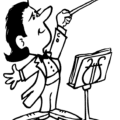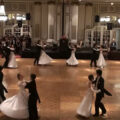Aug 23, 2016
Secrets of Conducting

We know what you’re thinking! Who is “we?” We conductors know what many audience members are thinking when you attend our performances.
From your perspective, it looks like a lion taming act!
The all-knowing, all-powerful maestro is cueing everyone in the orchestra. Small gestures, a tiny flick of a wrist, elicit gigantic changes in the volume level of the sound.
Yes, we know what you’re thinking. . .and some of us conductors may have even harbored similar notions about conducting when we were children or adolescents. But! When the moment came for us to actually play in a symphony orchestra (and many conductors began their professional lives as orchestral musicians), we learned one of the first secrets of conducting!
If you played in your high school orchestra or any other orchestra – you undoubtedly learned this yourself.
The musicians actually make the sounds. And in order to do this effectively, they must first obey Itzhak Perlman’s dictum: “The most important thing to do is really listen.” And by this, Maestro Perlman was not referring to the kind of listening as appreciators we teach at The Discovery Orchestra.
In order to perform well in an ensemble – whether there are two musicians or one hundred musicians – one must constantly listen to oneself and the other musicians simultaneously. The brain becomes highly trained to instantly recognize tiny discrepancies in intonation. “Am I playing ‘in tune’ with everyone else?” And the body instantly responds by fixing any issues.
Equally important: “Am I in exact sync with everyone else?” This is the phenomenon musicians refer to as ‘ensemble.’ Are we performing ‘as one’ rhythmically? Again, we know what you’re thinking. “Isn’t the conductor beating time?” Yes, of course. But all the time beating in the world won’t help one hundred musicians perform ‘as one’ if they are not really listening to each other – or if they are not motivated to do so.
Now we’re delving into the area of inspiration. What makes a conductor inspiring to players? Many attributes – most of which are transmitted during the rehearsals that precede the performance. These attributes include, but are by no means limited to: a profound knowledge of the score, reliable conducting technique, and perhaps most important, really passionate convictions and feelings about the music.
I know that last one sounds ridiculously obvious. But if a conductor does not have a really moving interpretation of the music that can be transmitted in a myriad of ways during the rehearsal period, professional players may not be motivated to really listen to each other. And far worse, they may never feel like ‘putting out’ – giving the performance ‘their all.’
One final secret. All the musicians in the orchestra have their own egos. This is as true for the last stand 2nd violinist as it is for the principal oboist.
I will never forget a session with my conducting teacher Richard Johannes Lert, an Austrian who was 96 when I studied with him. His pedigree was impressive; Richard Strauss had been one of his teachers.
Here were ten young conductors in one of our first meetings with the old maestro. Typical of young conductors, we were probably waiting for Dr. Lert to tell us the secret of controlling an orchestra. Instead, he said softly in his Austrian accent: “When you come to the rehearsal, before you begin. . .look at the first oboist, look at one of the members of the viola section, look at the first horn. And in your eyes communicate: ‘What wonderful thing do you have to say about this music as you play today’?”
Richard Lert, whom Johannes Brahms had bounced on his knee when Richard was a child, was saying to us that we should make every player in that orchestra feel that they are important and valued. What a concept! Think on these things the next time you attend a performance.





